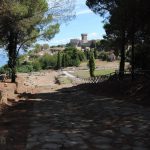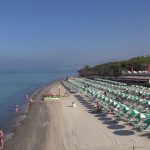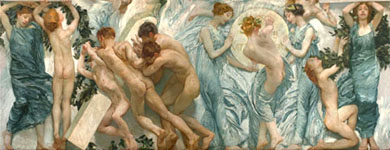
Edward Borrani
Pasture in Castiglioncello (1861)
oil on canvas, cm 30,5 x84
Signed lower left: O. Borrani
He went during the summer of 1861 along with Sernesi Pistoia Apennines, Borrani fails to show up at the Promoter of the same year with Florentine works in that location, so as to be ascribed to Yorick in the “school news” in the same way by Signorini and Cabianca, in turn vets stay in La Spezia: “The gentlemen Cabianca, Signorini and Borrani belong to the school news that effects people of the call, and exhibit three paintings according to their consciences” (Yorick, 1861, p. 177). The technical testing initiated by Borrani during their stay in St. Marcello Pistoiese is deepened in the presence of the scenarios of Castiglioncello, with outcomes similar to those of Sernesi brightness, according to the well-known comparison established by Cecchi in 1926 between La Punta del Romito view from Castiglioncello of Sernesi (1864) from Castiglioncello and Vada view of Borrani (1864), considered by the critical work of the same hand. In this pasture, the artist expresses an impression on the other hand absolutely individual, which is the same as Orto in Castiglioncello (1862-1864) and House and marina in Castiglioncello (1862-1864), according to which the investigation of the suit harmony of nature coastal combines the interest for the life of the fields returned through the epic story of peasants outlined with elegant draughtsmanship of ancient setting. It is precisely the definition of compositional groups, usually peasants surrounded by animals, which captures the artist’s draughtsmanship wisdom, gained from the study of the frescoes by Paolo Uccello in the Green Cloister of Santa Maria Novella and Giotto in the church of Santa Croce (Cecioni, 1905, p, 339), as well as that solid plastic, consistent with the research chiaroscuro typical of his “excessive fanaticism for the new art” (ibid., p. 338).
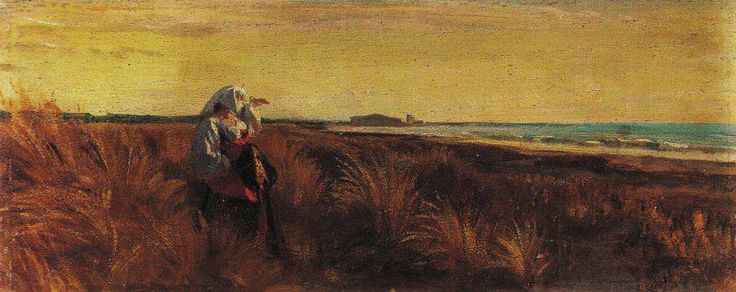
John Costa
One evening in the Maremma 1855
oil on canvas, cm 10,6 x27, 5
Signed and dated on the back by the artist:
One evening in Maremma Giovanni Costa 1855
On the basis of this affinity with the painting preserved at Castle Howard, exhibited at the New Gallery in 1890 with the title Bocca d’Arno (1889), Nicholls advances already in 1982 the idea of a setting on the Tuscan coast, until, as a result of further study of the architecture depicted in the background, the same be Nicholls concludes the coastal town of Lorraine at the fort of Bocca d’Arno, where, among other things, the artist in his memoirs that he had entertained guest at the customs officers around 1856. The commitment of Nino Costa at Marina di Pisa is substantiated by a color and Atmospheric Research, which aims to accentuate the striking note of the location, as in this sunset effect, in which the pitch of heaven repeats the golden range of coastal vegetation , albeit in a shade brighter, to confirm what the artist to concentrate on specific issues and techniques to discuss it with students who assisted him in his routes. The influence of the Roman in Tuscany, identified by Cecioni as “the most beautiful and most important page of the artistic life of the Coast” (Cecioni, 1905, p. 327) coincides with indications of a stylistic as well as expressive as refers Discovolo later, Antonio: “All of a sudden he stopped and with an eye toward the sky and said,” You see there, under that blue, there’s the red, as there is blood under the skin. Keep this in mind when you paint. The preparation of a painting is of great importance “(Discovolo 1983, pp.. 63-64).
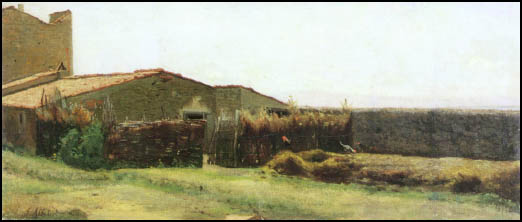
Giuseppe Abbati
The house of Diego Martelli in Castiglioncello (1862)
oil on canvas, 21,3 x50 cm
Signed lower left: G. Abbots
The survey aimed at defining the bright color characteristic of the Tuscan tenements subject to change time and season, according to the phases identified in the different versions of Narrow street in the sun, unfolds in this painting with a wider range of prospective breath, so as in other works in Castiglioncello, including View of Castiglioncello, also depicting the property Martelli. The need to assert a original appearance at an event in favor of his own inspiration which outlined the stay along the Tyrrhenian coast, abbots coincides with the search for a combination of personal touch tones, according to the testimony of Hammers: “But as the palette gives us so many endless combinations to equate the endless combinations that match all of the things subject to light in nature, he tried in a lower tone of the true to give the whole tone of the true “(Martelli, post 1870). Moreover the changing light conditions in the sea, as well as the variety of appearance of the Tyrrhenian coast, he had to solicit abbots to final outcome, given that the last letter sent by the artist to his friend the art critic, he argued that “felt called to come to this happy of his work” (Martelli 1877).
Vincenzo Cabianca
Beach in Viareggio in 1865
oil on canvas, 40×77 cm
Signed and dated lower left: V. Cabianca 1865
The discussions were held alongside Signorini and Cristiano Banti during your stay in La Spezia in 1860, substantiated by “works and attempts arditissimi,” coinciding with “real progress” in terms of yield of light phenomena (Cecioni, 1905, pp. 335 -336), continues to Cabianca in subsequent years, as part of a series of views acclimatized along the coast of the Tyrrhenian Sea, from Versilia in La Spezia, coinciding with the stops inside the sight of the sea, where the artist is able to deepen “the effects of the sun” (ibid., p. 335) with the intention of militant: “In his works, especially in the first, the pursuit of light and dark and color ratios is certainly bold and daring than arrogant” (ibid., p. 332). The regret of Cecioni about the unnatural hue palette Cabianca, as well as the condemnation of Signorini about the excesses of Bathers color among the rocks, delineate the coordinates of conduct original technique in the presence of the navy, consisting of color and boldness light is not quite in tune with that investigation on the relationship of tones that was perfected within the macchiaioli. It should be pointed out, however the distance between the impression experimental Bathers among the rocks, where Signorini deprecates the drafting of “a sky so weight and missing nitrogen” and the lyrical tone of this marina, which is evident in the delicate purple color modulation profiles mountain that fades with natural agreement in the expanse of the sky.
Giovanni Fattori
The libecciata (1880-1885)
oil on canvas, cm 19,2 x32, 2
Signed lower left: G. Factors
Gallery of Modern Art Palace
Pitti, Florence
The feeling of the season and the place shall base this up to make it one of the most distinct evidence of the stylistic path of factors, which started in sixties with the wind Manes (1867) and matured in the eighties, coinciding with the evolution from the view the landscape-realist state of mind. The ability of factors to finalize the technical experiments to yield expression of the reason is intensified in the production of marine eighties, especially in the two versions of the Libecciata, where the compactness of the inlays tone gives way to a drafting vibrated to such an extent as to foresee certain outcomes at the turn of the century of real sea-state of mind, which Sunset on sea (1899-1900). The fulfillment of ongoing research by factors in the wake of the lesson of Nino Costa, from The Macchiaoli, exhibited in Florence in 1867 and appreciated by Signorini in terms of evidence of ‘”impression […] of the season” and “character the country, “is even more evident in the sight of the marina, where the identification of the color of the season, and it joins with local weather broader issues, so as to involve one of the most daring protagonists of the pointillist technique, or Lloyd, who in 1929 confesses tried ecstasy in front of the painting: “Once I was bowed to the ground in admiration before the canvas representing a sea upset by the south-west with the tamarisk rabbuffate by the wind. Enraptured by the beauty I was in ecstasy” (Lloyd, 1929, pp. 20-21).
Giovanni Fattori
Waterfront Antignano 1894
oil on canvas, 60×100 cm
Signed and dated lower right: pl Factors 1894
Museum G. Factors, Municipality of Livorno
It dates back to 1894, a letter of factors to Adele Galeotti (Livorno, July 31, 1894), where the artist admits rhythms of execution rather loose, except a marine “1 m., And about 60 cm,” or this Promenade, which is with certainty the setting in Antignano, at the villa of “Miss Civelli”: “I do not fo almost nothing for now – that is, no nothing – fo nothing less than a frame of 1 m., and 60 cm – from the truth – Land and sea – will see it – here’s why … – Miss Civelli who all’Antignano (place of bathrooms far from here 4 miles) a beautiful villa, and I do pandant as it was with her when we went on the lake Trasimeno. ” The survey of tonal variations intensifies in the presence of marine Livorno, but always on the basis of the belief expressed by realist factors in 1891, according to which there is no need to alter the light gradation in view of spectacular effects, “the manifestations of nature are immense, are large, not always living presence of light, not always looks sad and dark “(Florence, February 1891). If the artist in this research the effect of sunlight, he is committed to maintaining a natural color, according to the dictates reiterated to the students on the occasion of the controversy concerning the luminous experiments of Muller. The condemnation of Factors in fact does not invest “attempt of light”, the rest by himself pursued with perseverance and innovative spirit, as the risk inherent in academia Mullerian a ‘”art without form or concept” and the “forgetfulness of all relationship of color and chiaroscuro “(ibid.).
Giovanni Fattori
Fishermen all’Antignano (1895)
oil on canvas, 44×95 cm
Signed lower left: Thu Factors
Since the early nineties Factors deepens the awareness of their artistic individuality, even in the presence of the trials of the students, so that in a letter to Nomellini of 18 January 1891, reports the consensus obtained from his works exhibited at the Promoter Florentine 1890-1891 “I have said and written that my works make a good impression, especially is very noticed my individuality.” The commitment of factors goes into this marina towards the synthetic transcription of one of the most picturesque in the Livorno coastline, where the crystallographic structure of the reef runs along a path investigated with painstaking dedication, so as to constitute an inspiration for other similar views . On this occasion, the artist achieves a completeness that assemble in a single visual composition phases, developed individually and then in a series of variations on the ground, such as Marina Livorno (Malesci 1961, no. 538), boats and fishermen (ibid., n. 645) and On the Beach (ibid., n. 752). In particular, the geometric definition of the sharp shapes of the rocks lapped by the waters is found as a reason in its own right in the Navy Livorno, while the combination, punctuated by a rigorous metric, between the silhouettes of fishermen and those of the hulls, appears with varied compositional intent in the other two marinas. In the presence of the coastal scenery, the artist does not intend to alter its conduct light outside of a normal track of correct relationships chiaroscuro, but prefers to identify the “form”, the “language” and the “feeling” of nature, in contrast to exasperation that technique pursued at this time by Muller, considered by factors such as the denial of artistic: “invoice nothing – nothing design – subject negative sentiment” (Factors, Florence 14 March 1891).
Signorini
Vegetation in Riomaggiore (1894)
oil on canvas, 58×90 cm
Signed lower right: T. Signorini
During the nineties the artist seems to focus on the issue of the navy in systematic terms, given that in 1895 even decide to lay a path of their own artistic experiences along the Ligurian coast, as evidenced Roofs in Riomaggiore (1892-1894) and from the sanctuary Riomaggiore (1892-1894). The attraction to the character of this picturesque coast is found mainly in the search for increasingly bold cuts in perspective, which call Signorini an emotional disposition of ever greater emphasis weather. In this marina is detected the appearance of a bold awareness light, as the search for an analytical definition of the foliage in the foreground is accompanied to the attempt of removal prospective horizon, via the gradation of shades of vegetation, clouds progressively until bordering the sea surface, whose atmospheric transparency in terms of natural joins with the sky.
Peter Senno
The Gulf of La Spezia (1901)
oil on canvas, 85×150 cm
Municipal Art Gallery Foresiana, Portoferraio
Present at the Promoter Florentine 1862 with a marine Elba, Reason took the Island of Elba, Peter Sense is dedicated to deepening the investigation Atmospheric coastal view in the course of its study routes near picturesque villages, including, in addition to ‘Elba Island, the Gulf of La Spezia, Portovenere, the Maremma, Bolster, Argentario. The way the initial of the artist, praised by Signorini in 1867 in terms of a “large bill” that “feels powerfully the impressions of true,” indulges in dark tones and special effects, again according to the critic, who urges him to make ” less heavy and black “and to have” a hand less easy “(Signorini 1867). The footprint is accompanied in this scenic view to increased sensitivity Atmospheric, according to the tendency noted by the Signorini in the eighties to a “prodigious easy to believe that impressions always have a very short shelf life” (Signorini 1884), which continued until the beginning of the twentieth century. The specificity of the evolutionary path of Sense is remembered by Mario Foresi, from detachment from the “academic conventionalism” of Markò and D’Azeglio, to the latest marine, where he turns “toward realism, toward the faithful representation of what that was offered to her look, more and more suffused with the light of his own imagination and shaded by a canopy of singular idealism “(Foresi 1904-1905 p. 236). The “edge Horace” maintained by the artist between the acceptance of the achievements Macchiaoli and conduct academic, enables it to provide a note to the genre of marine atmospheric greater verisimilitude, without sacrificing the scenic register, so that his last “Thalassica” collect the critical appreciation of the twentieth century, and his LIBECCIO over the admiration of Vittorio Corcos, gets the prize by the jury of the exhibition of Modern Art in Florence in 1902.
Tito Conti
Channel, Viareggio 1883
oil on panel, 14×24 cm
Signed lower left: Tito Conti;
dated on the back: Fair charities,
Viareggio. August 15, 1883
Devoted to the Seventies to a production of usually very close to that of Francesco Vinea, made with “great care and love quite unique” (Carocci 1875), Conti resolves, in the course of the eighties, in a pictorial behavior more staff, in line with the technical experiments of the Tuscan school. The verve sma retailer of this marine Versilia makes note of the artist’s desire to revise the dictates of a gracefully as academic in light of a technical effort, without forgetting the basic draughtsmanship, monsters all the skill of a modern colorist.
Tito Conti
The Dock. Viareggio (1885)
oil on cardboard, 14,5 x24 cm
Signed lower right: Tito Conti
Signorini Included among the “talented artists” with Francesco Vinea, Bartolomeo Giuliano, Peter Sense and Raimondi (Signorini 1867), Tito Conti must be ascribed to that group of Tuscan artists engaged in updating of genre painting through the acquisition the technical principles established themselves in the course of the eighties. One of the consequences of this update is to concentrate on those grounds that the artist most lent themselves to the application of a new way bright, in harmony with the conduct of others, which Vinea and Faldi, devoted to a study in the same year by the tireless true. And it is just in front of the harbor and the beaches of Versilia Accounts that can change their language, perfecting the science of tonal relationships, and drawing upon a thematic stimulating panache and relevance.
Ugo Manaresi
The Ardenza (1892)
oil on canvas, 77×200 cm
Dedicated lower left: E. A Virgil Livorno 18 (?)
This marina is an exemplary witness of the variety of inspiration in the marina, not separated by a “commendable” tonal conduct, recognized by Signorini Manaresi since 1879. In addition to the genre of the allegorical painting The man and creation – exhibited at the Promoter Florentine 1880 – and the romantic shipwrecks to Salvator Rosa, the artist cultivates in fact a record of realistic footprint, from the Florentine Promoter of 1881, which In presents new dock (Marina), Exposition of Livorno until 1886, when it manages to establish itself as an artist specializing in marine, always with two reasons the dock Livorno. In the late eighties and early nineties Manaresi thus appears to be engaged in the bedding of their vision from the truth in front of the coast of Livorno, to develop a certain detachment from the repertoire of the conventional kind sailor and to prepare a pictorial address more personal. This marina, conception similar to that of The Mug. Livorno (1889) – played by Mazzanti in 1941 – would seem to ascribe to the latter phase, as there you can recognize the deepening of a study from life on the coast dell’Ardenza, made with a technique so wise and bright with a writing so detached, still be present in the twenties Vinzio eye of Julius Caesar, who also specializes in marine, as well as friend and admirer of the artist: “The brushwork is edgy, nervous, without regrets or concerns of a technical or fashion, it is clear, firm and secure “(Vinzio 1927-1928 p. 46). The ever-increasing dedication to study from life allows the artist to switch part of their production activities of various official destination, such as a few shipwrecks, with a footprint of more intimate – as confirmed by this marina – which is that left a legacy for future generations, according to the testimony of Vinzio: “In tablets, studies and clipboard, which he painted for himself, he was very effective” (ibid.
Ugo Manaresi
Bathers at Quercianella 1894
oil on canvas, 97×44 cm
Signed and dated lower right: U. Manaresi 1894
The work must reconnect certainly a painting by Gino Mazzanti quoted on the “Journal of Livorno” 1941: “in a sketch treated with broad brushstroke and juicy, which is titled Bathers, bleak cliffs against the light of the sunset, naked women from the forms of siren and the iridescent waters give life to a strange composition between myth and reality “(Mazzanti 1941, p. 90). The inclination of the register Manaresi allegorical stood up from 1880, when he presents himself at the Promoter Florentine with man and creation, but continues over the next several years, as confirmed by Mazzanti in this reference to “attempts to representations symbolic and fanciful and vague reasons compositions idyllic and pastoral “(ibid., p. 79). The commitment disegnativo sculptural artist in the definition of women’s bodies, it goes in this marina to a renewed awareness of light, compared to the series of Shipwrecks of the first period, especially with regard to the yield of the illusionist brown cliff Avanti composition, whose dark shades stands out in contrast to the sea surface, animated by the latter suggestive transparencies. The use of a refined elegance of the section designed as the delicate orchestration of color glazed, increases the effect of suspension of the scene, allowing you to ascribe this to the trend of “marine between dream and reality, similar to those of Claudio Lorraine “(ibid.).
Adolfo Tommasi
The diligence of Castiglioncello (1880)
oil on canvas, 32×59 m
Signed lower right: Adolfo Tommasi
At the date 1880 Adolfo Tommasi appears to have already made a first fundamental reflection on the problems atmospheric joined to the view from the truth. This reflection, which emerged in the episode’s official After the ice (1880), is exposed to anti frontloading studies Promoter Florentine year, favorably noticed by Signorini, in particular a “bozzettino … very, very full of light , relief, intonation “and Autumn, where” the sky has a bright depths “(Signorini 1879). The maturation of conduct light allows the artist to compete with the registry more complex view of the coast, in which the reason of the Tyrrhenian coast seen foreshortened, as well as being a test case for other Tuscan artists, first of all Luigi gioli, committed to such an extent Adolfo, intent to see it the same reason, in even more programmatic in Littorale Tuscan exposed to Florence in 1887. On this occasion, the artist aims to animate the coastal road with the introduction of a colorful design, that of the carriage, which contributes to the charm color of the scene, in addition to the measurement of the succession of planes in depth, and then to the suggestion of the ‘perspective effect.
Vittorio Corcos
Marina (1895-1900)
oil on canvas, 37×52 cm
Signed lower right: V. Corcos
Analogous to the compositional approach to marine Signorini in Riomaggiore, this work demonstrates the artist’s preference for a situation of greater emotional impact than the usual serene view of the Tyrrhenian Sea, which is typical of works such as the sea Reading (1910) and The Cuddihy (1915). The artist focuses in fact made of a marina on the storm which enhances the impression gloom, darkening the tone of the vegetation in the foreground, muffling the tone of the expanse of the sea and obfuscating the transparency of the sky with a relentless crescendo of colors gray. The yield of these effects Corcos place within the group of Tuscan artists in an attempt to return the emotion received, contribute to the evolution of the navy in terms of landscape d’animo-state, which is accompanied by a constant observation of the true that engages the artist in terms of the surrender of the local color and the characteristic profile of the marina.
Vittorio Corcos
Ada backlit 1905
oil on canvas, 56×46 cm
Dedicated, signed and dated lower right: To my dear Ada May 1905 V. Corcos;
signed lower left V. C.
Baptized by Ugo Matini “the cute painter of the graces feminine”, Vittorio Corcos this gives the suggestion of a silhouettes, softened by the vibrations of light filtering through the doorway spreading across the view of a suspension, which is in itself an expression of a state of mind. Years earlier, with flowers hedge (1891), he explored the effect of the bright backlight on the threshold, emphasizing the intent portraiture; intent here mitigated by the glimpse of the sea, to which more than a portrait, it is thought , for an “open window” (Tarchiani, p. 261). Under a succession of carefully-gauged against the Avanti of the composition, the only chromatic note of compactness is unalterable fact, bright enamel outlining the expanse of the sea in the distance, extreme gradient prospective view.
Vittorio Corcos
Castiglioncello 1910
oil on canvas, 72×133 cm
Signed and dated lower right: V. C. Castiglioncello 1910
As early as 1890 Corcos had captured the attention of critics as a marine painter, when Fonseca speaks of him in terms of “delicate artist who once had from her earliest work a predilection for the sea, but always for a calm sea equal to its painting. ” In particular, the hint of Fonseca to a Ligurian sea, on the beach, denotes the presence in Corcos, in the same way that in Gioli and Tommasi, of that will upgrade technical as early as the nineties through new coastal itineraries, where find out more picturesque scenery for their own reasons. Moreover, the setting of the female figure in front of the sea becomes Corcos, as well as other Tuscan artists dedicated to the study of feminine, such as Arturo Faldi and Italo Nunes-Vais, a chance to animate the conduct essentially draughtsmanship with a renewed Atmospheric sensitivity. The identity of inspiration for this work with a marine Faldi, exposed to the Promoter Florentine 1907-1908, pending a visit desired, as well as a marine-Nunes Vais set in Versilia between 1905 and 1910, Scanning the horizon, allows us to reconstruct a fabric of relations between Tuscan artists, who, during the first decade of the century, continue updating your language brighter and therefore more scrupulously investigate the coastal landscape, so that Corcos holds more and more frequently on the coast of Livorno, while Faldi and Nunes-Vais move on the coast of the Tyrrhenian Sea, the first to Portovenere, the second in Forte dei Marmi.
Vittorio Corcos
The Cuddihy 1915
oil on canvas, 120×125 cm
Signed and annotated in the lower left: V. Corcos THE cuddly ‘in 1915
The propensity monumental artist was often demonstrated in the field of portraiture, there is also the presence of the sea, as had been foretold by Soderini Countess Frankenstein (1889) and In reading the sea (1910). It follows a similar pictorial behavior, guided by the plastic clarity and brilliance of tone, while the outline disegnativo back to return to the human figure quell’incisività typical of female portraits of the artist. More than in previous marine, the artist here focuses return the exact optical reflections of the expanse of the sea, which is colored in bright notations, so as to foresee the echo of technical research has long been probed by Tuscan colleagues.
Alfredo Muller
The Bagni Pancaldi in Livorno in 1890
oil on canvas, cm 73×53, 5
Signed and dated lower right: Alfredo Muller. Livorno / April 2, 1890
The technical update of Muller on the “new verb impressionism luminista monettiano” (Tinti, 1921, pp. 156-157) is accomplished, according to the testimony of Mario Tinti, the date of 1890, with the stated marine Livorno, become immediately a “textbook” for many painters Livorno. In confirmation of such visual suggestions were to offer the bright coastal views from Livorno for the application of the “new technique in small strokes, full-bodied, uniforms and flickering” the artist, returned from Paris, is presented to the Promoter Florentine 1890-1891, just with a Marina (vibration white, yellow, blue).
John Bartolena
Marina in Castiglioncello (1925-1930)
oil on panel, 26×37 cm, 8
Signed lower right: Joe Bartolena
On the occasion of the exhibition at the Gallery “The Exam” in Milan in 1926-1927, Renzo Boccardi Bartolena defines “love of his city […], I pay of the sea and of the sky”, distinguishing between “design and solid masses full, the one and the other made of color “still lifes and the emergence of macchiaiolismo in ‘” eclogue sparkling “landscapes. Of the eleven paintings on display, five were marine, set between Chioma and Quercianella, confirming coastal inspiration of his painting. Defined by Somarè “painter by right of nature” (Somare 1927) and extended by Giolli “in quell’irrigidirsi be simplified and spirit that we already know from Factors to Mario Puccini” (Giolli 1927), Bartolena shows, especially in the sea, where they place along with Lloyd, Ghiglia and Puccini in that line of return to tradition, as part of a recovery of a Fattori filtered through meditation on the primitive.


